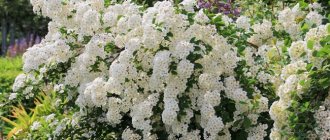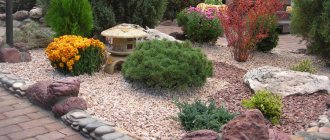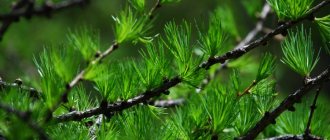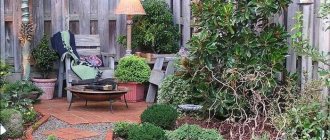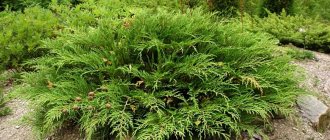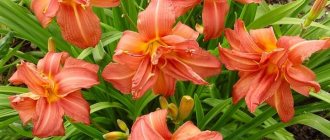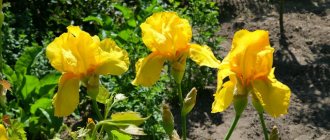A spectacularly designed suburban area is not an accident, but the result of painstaking work. In fact, beautiful flower beds and lawns cannot appear suddenly... On the other hand, even an amateur gardener can make a plot interesting and unique in its own way.
Creating a beautiful composition in landscape design is not as simple a task as it might seem at first glance.
The principle of dominant, accent and background
The dominant feature on any site will be the house. The garden is an extension of the house. The house and garden should be in the same style.
If this does not happen, a feeling of discomfort arises. And no matter what money you spend on plants for your garden and no matter what efforts you make, you will not be able to create a real garden.
Then we can talk about accents. These are groups of the largest, most noticeable and colorful trees and shrubs. When creating any compositions, they are always there.
The accent can be a pond, stream, gazebo. There shouldn't be too many accents. Otherwise they will cease to be accents. And our composition will turn into a banal set of plants and small architectural forms.
When composing a composition, the background is very important. No composition will look good against the backdrop of a decrepit fence or a neighbor’s vegetable garden with potatoes. The background needs and can be created. The background can be a fence, a hedge, a view of a forest or field, or a lawn.
2. The principle of nuance
The composition is based on the principle of nuance, when the constituent elements are similar to each other.
An example of a composition based on nuance would be a mixed flower bed of perennials of different shades of pink or a composition of clipped round plants of different sizes.
The principle of contrast when composing a composition in landscape design
Contrasting colors are colors that are opposite each other on the color wheel.
Contrasting colors have this wonderful quality: they enhance each other's effect. Red on green, purple on yellow, orange on blue seem brighter. Even if there is very little color, it will be noticeable against a contrasting background.
In landscape design, it is undesirable to use contrasting colors in equal quantities. There must be less of some color, more of some. If we take plants that are equal in size and contrasting in color, then the optical balance will be disturbed and our composition is unlikely to be harmonious.
Color circle. Contrasting colors are opposite. Contrasting colors: red and green, yellow and purple, etc.
You cannot use several groups of plants of contrasting color next to each other. There should always be a neutral background.
Plants can be contrasting not only in color, but also in shape. Plants with contrasting shapes are cone-shaped and spherical, columnar and spherical, columnar and prostrate.
The principle of an equilateral triangle
This rule is used not only by landscape designers, but also by artists, photographers, and florists.
Plants or small architectural forms are placed in such a way that an unequal triangle is visible along the contour. One of the elements should be the highest, the second - slightly lower, the third - the lowest.
The triangle does not have to be straight. If one of the corners turns out to be right, then one of the elements may obscure the other and the entire group will not be visible. That is, there will be no group.
If we take the triangle rule in general form, then it will be the rule of three. Three shapes, three sizes, three colors.
A path laid from tiles of 3 different sizes of the same color looks good. Compositions made of stones can be laid out according to the principle: large-medium-small.
Composition of a one-way review
A one-way view composition in landscape design is a group of plants and small architectural forms viewed from only one side. Most often, one-sided compositions are created against the wall of a house, a fence, or against the backdrop of a hedge.
The optimal distance from our composition to the view point should be equal to the height of the plant multiplied by 2 or 2.5. That is, if it is assumed that the bush will grow to 1.5 m, then the optimal distance from it to the viewer is 1.5 x 2 = 3 m.
This rule does not mean at all that a tree whose height will be 10 m must necessarily be planted 20 m from the observer. If our plant grows larger, then usually we will not see it in all its glory, but will observe only a fragment of it.
When conceiving a composition for a one-sided view, you can and should use plants of the same shape and size. Or simply - the same plants at certain intervals. This will give a sense of rhythm and continuity.
One-way view composition
When composing a composition, you need to remember that some plants will dominate, others will act as a background.
It is foolish to buy the most beautiful plants in your opinion at the garden center and plant them all together in one group. It won't be as beautiful as it will be expensive.
It is much better to create a composition using background plants that highlight the beauty of the accent plants. Here, look out for plants with silver foliage. By themselves they are not always beautiful, but in a group with others they are simply a miracle! Plants with silver foliage: angustifolia and silver oleaster, sea buckthorn, various willows, wormwood, some sages, etc.
A special case of a one-way review composition would be a mixborder.
Landscape design in Minsk and the region:
tel. : +375-296-67-61-06
Share on social media networks:
Laws of color
Since ancient times, mystical properties have been attributed to color based on its perception by humans. In the color symbolism of the Ancient East: red meant virtue, yellow – health, green and blue – wisdom, white – cold and purity, black – strength and sin. I. Newton made an important discovery: “a sun ray, which is perceived by the human eye as white, when refracted in a trihedral prism, is decomposed into seven colors of the spectrum.” He also proved that this series of colors and their order were constant, thus creating the first "color scale". You have all seen a rainbow more than once, which is formed by spectral colors (red, orange, yellow, green, blue, indigo, violet), arranged in an order corresponding to the well-known saying: “Every hunter wants to know where the pheasants are sitting.”
To correctly combine plants of different colors and place them on the site, it is necessary to take into account three main characteristics by which one color differs from another.
Psychophysiologists have established that color is the first factor affecting a person, among sound, smell and taste. Therefore, to create an artistic garden on your site, in addition to knowledge of plant biology, it is necessary to take into account the laws of color harmony.
1. Chroma
Color tone is characterized by the wavelength of light reflected by any surface. Therefore, green grass and yellow flower are identified with a certain tone. Spectral colors are usually represented as a color circle divided into six parts. It includes 3 primary colors (red, yellow, blue) and 3 additional colors (orange, green, purple). Depending on the degree of detail of the shades, the color circle can be divided into 6, 12, 18 or more parts. Thus, the color wheel, consisting of twelve parts, includes, in addition to the seven colors of the spectrum, purple (obtained by mixing red and violet), as well as shades: light green (yellow-green), golden (yellow-orange), crimson (orange -red), cornflower blue (blue-violet) and turquoise (blue-green).
Research by scientists has revealed a close connection between color and the physiological and emotional reactions it evokes. Yellow color is similar to the sun: the brightest spot is the solar disk and from it the light diverges in concentric circles, losing its brightness and expanding space. The blue color is like a funnel of a sea whirlpool that “draws in and absorbs” space, its center is the darkest place. According to the degree of excitement and the nature of the impact, colors are usually divided into warm and cold. Warm tones always seem larger and closer: they seem to come forward, while cold tones recede and seem further away.
Warm yellow-orange-red colors of “fire and sun” are more joyful and active. They are preferred by people with a dynamic character: emotional, passionate, energetic. These tones
evoke a feeling of joy and cheerfulness, and their muted cream and pink shades evoke a feeling of comfort and peace, harmony and well-being. Cool greens, blues and purples are associated with shade and coolness. Light shades of blue and green are calming, while dark and violet colors evoke feelings of anxiety, sadness and restlessness. Cool tones are preferred by calm and delicate people, with a creative approach to life and striving for emotional comfort.
2. Saturation
In total, there are about 130 color tones in the visible spectrum. The difference between them is provided by the second characteristic of color - saturation. It helps determine how much the color of one plant appears brighter or muted than another. Spectral colors have maximum saturation: it is taken as 100%. Yellow and orange plants (evening primrose, solidago, eschscholzia) have the greatest saturation, since their color is almost close to the spectral one. Plants with red flowers also have rich colors: roses, tulips, peonies, poppies. Blue, blue and purple plants (forget-me-nots, Japanese iris, cornflowers) have low saturation. And achromatic ones: white, black and gray can be called colors with zero saturation.
3. Lightness
Achromatic, which means “colorless”, instead of color, have one characteristic – lightness. It serves as a measure of brightness and is the third characteristic of color.
Compare dark purple aquilegia and light purple aster bush, or pale pink phlox subulate with dark pink primrose. With the same saturation, the color of these plants has different lightness.
When starting to design your site, you need to decide whether your garden will be bright, surrounded by a variety of colors, or whether you want to create a calm, pastel composition of plants. In any case, you should adhere to certain rules for combining colors, which have different effects on the psychological and physiological state of a person.
Mixed flower garden
We offer services for creating mixed flower beds and mixborders.
Mixborder is a mixed flower garden that includes mixed plantings of perennial plants, shrubs and trees. Low-growing plants are usually planted in the foreground of a mixed flower garden, and taller plants are planted in the background. Plants are selected taking into account environmental requirements and seasonal decorativeness. A mixed flower bed looks very good against the background of a hedge. Border design... Read more
How to visually increase the area of the site?
When choosing summer cottage ideas for a small plot, you should abandon the tendency of gigantomania. No large buildings, but distribute existing ones throughout the yard, masking them with bushes or alternating them with free spaces as a recreation area. Instead of many, there are several plantings that look harmonious. Replace large trees with low-growing fruit trees, do not put a blank fence around the yard, otherwise it will be uncomfortable, cramped and gloomy inside.
Smoothed shapes and smooth lines visually increase the space. Paths winding between flower beds highlight distant corners with bright colors. Do not overdo objects, leaving empty spaces.
Winter hardiness and frost resistance of plants
Winter hardiness and frost resistance of plants are different concepts, although close in meaning.
Winter hardiness is the ability of plants to withstand a complex of environmental influences during the winter and early spring periods. This includes the ability to withstand spring burns, low temperatures, damping off, soaking, and the ability to withstand frequent temperature changes. Frost resistance is only the ability of a plant to tolerate low temperatures. Frost hardiness zones (USDA zones) are areas into which the territory is divided depending on... Read more
Dividing the site into zones and sections
Carrying out the arrangement of a summer cottage inexpensively includes dividing the territory into several places that have a functional load:
- front door - comes from the gate / gate, where people come or cars arrive, occupies 6% of the territory;
- recreation area - 10-14% of space;
- household - a garage, greenhouses, bathhouse, etc.;
- playground - area for children's entertainment;
- gardening - 75%, if the owners are engaged in this.
The number of zones and their purpose are discussed at the project development stage. Several can be combined to save space, others can be removed or added.
Landscape design project price
Landscape design project: price and what affects it.
The cost of a landscape design project depends on the number of working drawings required to complete your project. Economy option. For a plot of 20 acres 38 $/area Drawings: Sketch of landscape organization, photo analogues of design, covering plan, list of materials, layout plans, landscaping plan, assortment list of plants. Standard option. For a plot of 20 acres... Read more
How to complement the landscaping
An elegant stone rose in a landscape design, created by yourself, or a rock garden, succulents on an alpine hill and even a pergola with flowers will decorate the area.
For territories, it is important to choose those elements that, according to the design style, will ideally fit into the composition of the landscape design.
When trying to choose a landscape design for a private house with your own hands, you can not limit your imagination and feel free to experiment.
Combinations of traditional flower beds and fences, decorative and functional elements will help enhance the uniqueness of any project and make it truly beautiful with emphasized practicality.
Organizing space: secrets of composition
When designing the landscape design of a garden plot with your own hands, you need to take into account the details:
- Natural relief – do not radically change natural “mistakes”, but play with them, so that unevenness turns from annoying hindrance into a source of inspiration.
- Soil type - affects the choice of plants to be planted.
- Location, cardinal directions - some plants love the Sun, others prefer shade. When arranging a recreation area, you need to protect it from gusts of wind, and the house from drafts. Regulate sunlight activity, doing more or less as needed.
- The size of the territory - the larger it is, the greater the scope for imagination.
- Stylistic preferences - after studying all design styles, choose the best one for yourself.
How to make a single composition - select all elements, from large to small, in a general style, so that they complement the picture and seem part of the whole. Shape, location, even color matters.
What are viewpoints and what are they for?
The design project for the site of a country house takes into account viewpoints - places from where the entire landscape picture is visible.
The view point is the center from where the full view opens. As soon as a person changes the zone, the point also changes, but the landscape canvas remains unchanged. You should select one central point from which all the others will be visible. Check how they fit together and add them to the plan.
Decorative elements: how to decorate a relief site
Do-it-yourself landscape design of a garden plot includes the selection of small details for decoration. By installing thematic sculptures, creating lighting and other elements, the owners create the atmosphere.
The most interesting of the decorative elements:
- Garden fireplace - you can make a classic one or replace it with a barbecue stove, combining the heating system with an outdoor cooking area.
- Lighting with individual illumination of plants will create a mysterious, romantic or warm atmosphere of the chosen place.
- Sculptures demonstrate the taste of the owners, their values and priorities. For example, garden gnomes, heroes of antiquity or the work of an amateur.
- Alpine slide is a mountain landscape depicted in miniature.
- Stones are a natural object. You can process them into a different shape and place them on the territory.
There's no need to hang themed decorations like a Halloween pumpkin or a Christmas tree. All decorative elements must be neutral.
Territory lighting
A competent lighting system makes the area accessible and safe at night. It can be utilitarian and decorative; it helps to create a special atmosphere in the garden due to the difference in light and shadow. You can highlight individual elements, for example, a fountain or figures. Install lamps for areas and take care of lighting the paths so that the entire area is clearly visible at night.
Benches and swings
Arrange recreation areas to spend more time outdoors. Place benches in the shade under the trees, hang hammocks and install swings. There are adult swings - elegant models for several people with soft seats. A couple of portable stools are also useful for gardening. It is more convenient to dig beds and plant plants while sitting.
Garden bridges on the site
They look beautiful even in places where there is no water. You can install a bridge in the center of a large flower bed or throw it across the “bed” of a dry stream made of flowers or stones. They are usually made of wood with railings for safe passage. The size depends on the width of the obstacle.
Sculptures and figurines
Figurines for the garden can be original supports for outdoor vases or a source of light like gnomes with lanterns. A place without grass can be easily hidden under a mushroom bench. Such elements enliven the atmosphere, adding originality.
Types of practical use of figures:
- emphasize important points in the composition;
- create a complete image, which is useful for large areas.
Cute things also look good in small areas. Animals, gnomes, fairy-tale characters - any will do, the main thing is to adhere to the general idea of the design style.
Alpine coaster
Looks good on real slopes. You need to decorate them with granite, limestone or slate - use only natural stones. Fill the remaining crevices with earth, sand and humus. Then dot it randomly with plants. A small waterfall will be an effective addition to the composition.
Fencing for flower beds
In addition to borders, wickerwork, miniature picket fences, factory-made paving stones, bamboo, wooden panels made to resemble bricks, forged trellises, etc. are used to fence flower beds. It is possible to beautifully decorate a personal plot, preventing flowers from growing beyond the boundaries of the flower bed and at the same time not blocking their beauty. The selected type of partitions is used for all similar objects.
Flower beds made of stones
Original compositions emerge from cobblestones of different sizes and pebbles. Craftsmen make stylish fences from them, giving the stone the desired shape. They build decorative streams or lay down soil, preventing weeds from germinating. Stones of similar shades look beautiful, complementing the decoration of the paths.
